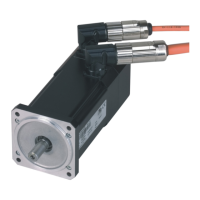Technical data
18 8LS...-3 user's manual V2.50
2.6 Motor encoder system (ee)
8LS b c d . ee nnn ff gg - h see "Order key" on page 13
8LS three-phase synchronous motors are available with EnDat encoders as well as resolvers. The motor encoder
system is listed as part of the model number in the form of a 2-character code (ee).
Analog and digital transfer
A resolver is an analog encoder system. Resolvers are particularly robust against vibrations and high operating
temperatures. Their disadvantage is the low precision of 6-10 arcminutes. There is still no multi-turn variant with
resolvers.
Digital encoders use a serial transfer protocol. This protocol is called EnDat. The EnDat protocol is a developed
standard that incorporates the advantages of absolute and incremental position measurement and also offers a
read/write parameter memory in the encoder. The embedded parameter chip is stored by B&R in this encoder
memory. This data and the B&R ACOPOS systems form a plug-and-play drive solution. Absolute positioning can be
used within a revolution with the single-turn variants. A homing procedure is not required because of the absolute
position measurement. For applications where the motor covers several revolutions for positioning, a multi-turn
encoder that can save up to 65535 revolutions can be used. A solution with a single-turn encoder variant with a
homing procedure is also possible. In EnDat 2.1 analog/digital sampling, a very fine resolution is achieved by the
evaluation modules developed by B&R.
2.6.1 EnDat 2.2
For the advanced, fully digital EnDat 2.2 protocol, the positions are generated directly in the encoder and commu-
nicated serially with the drive system. This transfer is very robust in relation to disturbances and is even certified
for safety applications.
EnDat 2.2 is therefore to be preferred over the older EnDat 2.1 variant.
2.6.2 General safety encoder
Safety-related position measurement systems
In machine and system manufacturing, the topic of safety is becoming more and more important. This is mirrored
in legislation and stricter safety criteria in national and international standards. Most importantly, stricter require-
ments serve to protect personnel, but they also increasingly serve to protect property and the environment. The
goal of functional safety is to minimize or eliminate dangerous situations that can occur in machines and systems
either with or without operational errors. This is generally achieved by implementing redundant systems. Moving
axes in safety applications require position information in order to be able to carry out their corresponding safety
functions. Different system configurations can be implemented to get independent position values. One possibility
is using two measuring instruments per axis. To keep costs down, the aim is often to create a solution with only
one position measuring instrument. Until now, analog measuring instruments with sine/cosine signals were used
for this purpose. The encoder manufacturer Heidenhain – as the first manufacturer with the purely serial EnDat
2.2 protocol for safety position measurement systems – offers a serial single-encoder solution per IEC 61 508
SIL 2. All the advantages of serial data transfer – such as cost optimization, diagnostics possibilities, automatic
commissioning and high-speed generation of position values – can now benefit safety applications as well.
100% inspection during production and additional measures during final testing ensure errors have not occurred
related to shaft and coupling connections on rotary encoders when using motors with safety encoders (per EN
ISO 13849-2).
There are also a number of safety functions that are already possible with D encoders.
2.6.3 Information: SafeMOTION
For information about the area of application and procedure for setting up the various safety functions, please
refer to the SafeMOTION user's manual (MAACPMSAFEMC-ENG) in the Downloads section of the B&R website
www.br-automation.com.

